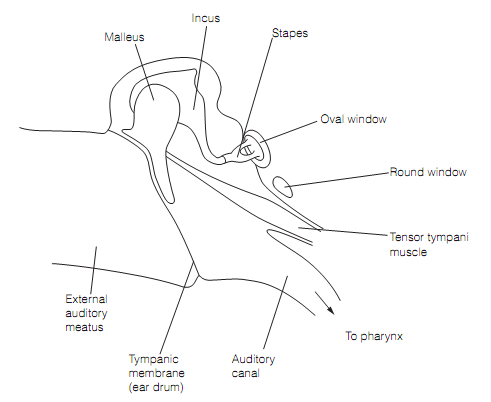The middle ear
The function of the middle ear is to convert pressure waves in the air to vibrations of the perilymph in the inner ear. Sound waves pass beside the external auditory meatus striking the tympanic membrane (ear drum) that resonates faithfully in response. The ear drum is vitally damped in that it stops vibrating the instant the sound ceases. Sound at hearing threshold causes the ear drum to vibrate with amplitude of around 0.01 nm—one tenth the diameter of a hydrogen atom. The movement of the ear drum is transfer with an overall effectiveness of about 30% to the fluid in the inner ear by a lever system, comprised of three ear ossicles, lying in the tympanic cavity as shown in figure below:

Figure: The anatomy of the middle ear.
The malleus (hammer) is fixed at its thin end to the tympanic membrane. Its thick end articulates with the head of the incus (anvil) through a saddle-shaped joint. The long procedure of the incus makes a ball and socket joint with the head of the stapes (i.e., stirrup). The base of the stapes is joined by an annular ligament to the oval window (fenestra vestibuli). The malleus vibrates with tympanic membrane. Inward movement locks the joint among the malleus and the incus, driving the long procedure of the incus inward, pushing the stapes in similar direction to exert a pressure on the perilymph beyond the oval window. This pressure wave is transmitted via the perilymph to cause a compensatory bulge of the round window (fenestra cochleae). The outward movement reverses these motions. As the region of the oval window is 20 times smaller than the tympanic membrane, the pressure (i.e., force per unit area) at the oval window is proportionally greater. This is significant as perilymph is incompressible and therefore must be driven to vibrate en masse. This requires more force than it takes to transmit sound waves through air. Additionally it results in an amplification of the sound by around 20 dB, corresponding to a four-fold increase in loudness, by the middle ear.
There are two middle ear muscles, the tensor tympani and stapedius. Whenever they contract altogether the handle of the malleus and the tympanic membrane are pulled inwards and the base of the stapes is pulled away from the oval window. This decreases sound transmission by 20 dB, particularly for low frequencies. Reflex contraction of these muscles in reaction to loud noise might prevent damage to the inner ear but as the reaction time is 40–60 ms this tympanic reflex afford no protection against short loud sounds. The auditory canal connects the middle ear to the pharynx that permits the air pressure to be equalized whenever changing altitude.